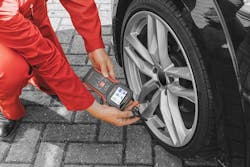Tire pressure monitoring service (TPMS) can be both regular and lucrative. Respondents to MTD’s 2021 Tire Dealer Automotive Service Study report that they perform TPMS service an average of 120 times per month. Respondents also report that the average profit margin for TPMS work is 65% — higher than air conditioning work, shock and strut replacement, brakes and many other services.
What are the main things that technicians should keep in mind when using TPMS scanners and servicing TPMS, in general? Here’s what representatives from various TPMS scan tool providers had to say:
John Rice, marketing manager, 31 Inc.: Keep your tool charged. There is nothing more frustrating than being in the middle of servicing a customer’s vehicle, reaching for a TPMS tool and realizing the battery is dead. We recommend charging your tool weekly.
Besides a tool that won’t power on, a tool that is not updated can be just as frustrating. Some TPMS tools — like the Smart Sensor — have lifetime free updates.
Also check the light on the dashboard. A solid light indicates one or more of the tires is significantly under-inflated. A blinking light — or the letters “TPMS” — indicate a system malfunction.
Confirm direct or indirect TPMS. Direct-style TPMS uses sensors in the wheels/tires. This makes up roughly 90% of all TPMS. Indirect systems work through the vehicles’ ABS. Even though they represent a small percentage of total vehicles with TPMS, it’s important to identify these vehicles early through your initial inspection. And test before you touch. After checking the dashboard light, checking sensors is next. This is done by simply scanning the sensors using your TPMS tool.
Emily Humpert, marketing communication manager, ATEQ: When using a handheld TPMS tool, it is important to keep in mind the position in which you are holding the tool in relation to the tire. In order to read the TPMS sensor inside the tire, it is recommended to place the tool’s antenna on the tire sidewall, next to the sensor. If the antenna is pointed through the rim, is on the wrong side of the tire or is not close enough to the sensor, the tool could get a bad reading or not get one at all.
Hiba Anjum, tech support supervisor, Autel North America: When I am giving potential TPMS technicians training, I explain to them the three main steps when it comes to TPMS — diagnosis, program sensor and relearn. If you stick to this order, no TPMS job will be difficult for you. Using our Autel ITS600, we list these exact options in order. The technician is encouraged to diagnose the issue first. This allows them to check each existing sensor in the car. So let’s say, for instance, one out of four sensors trigger. That means three sensors need to be replaced. In this scenario, the technician would be better off replacing all four sensors. Otherwise, the last sensor will also be on the way out. If all four sensors trigger, then it means we might have to relearn these sensors to the vehicle. In this case, we will assume that we have to replace the sensors.
The last step — which is the most important one — is to relearn that new sensor to the vehicle. Completing this step successfully is what will turn that TPMS light off.
Scot Holloway, CEO, Bartec USA: We have always adopted a process-oriented approach to TPMS service. Typical TPMS service steps include determining the make, model and year; “test before you touch”— inspecting the vehicle’s sensors and control modules to best understand the issues; sensor programming — the process of configuring replacement sensors prior to use; and TPMS relearns. Most solid TPMS tools have this capability now. Of these four basic TPMS concepts, pre-inspection is key. Pre-service inspection achieves many things for the technician. It establishes a baseline of the vehicle’s TPMS. Are all the sensors in fact working? Are there TPMS-related diagnostic trouble codes in the control module?
Once the condition of the TPMS is determined, you can now offer the customer an accurate account of their TPMS and what it may require to make it operative. At the very minimum, “test before touch” can uncover a broken or faulty sensor when there may not yet be a MIL. Without this inspection and finding the faulty sensor, technicians leave themselves open to owning the customer’s problem.
Sean Lannoo, sales technical training supervisor, Continental: The most important first step technicians should take is to do their homework when shopping for a tool because not all TPMS scan tools are alike. Does the tool work with a majority of OE and aftermarket sensors? Is the tool capable of handling your shop’s service work? Can it read diagnostic trouble codes? What is the cost for updates? Does the tool have an option for tire management, such as a tread depth gauge? Being able to check tread depths is not only a great selling feature, but also a valuable customer benefit. How do you enter vehicle information? Some tools have the capability to scan the vehicle’s identification number and pull up model, make and year quickly and accurately. Is the tool’s user interface simple to understand and use? And is the screen readable in all lighting conditions? This is key, especially in shops where lighting is low or restricted.
Jake Henderson, sales and technical support manager, Hamaton Inc.: Technicians must ensure their TPMS diagnostic tool is kept up-to-date. That’s because each software update includes increased coverage, meaning they can service more vehicles. (The Hamaton H56’s Wi-Fi update feature has made it easier than ever to keep it updated.)
Before servicing a TPMS sensor, the technician should identify whether the vehicle has a low-line or high-line TPMS. Low-line systems trigger just the TPMS warning light when a tire is underinflated. High-line systems display the pressure of each tire on the dash, reporting the location of a malfunction.
Technicians should not assume all models have the same TPMS because some can be low-line or high-line.
Yanick Leduc, global technical training manager, Schrader TPMS solutions: On top of sufficiently charging your tool before usage, our number one (piece of) advice is to always keep your tool up-to-date with the latest software available.
Every TPMS tool manufacturer releases frequent software updates that provide new and improved features, content and capabilities. Tool manufacturers often use updates to fix “bugs” and improve performance. More importantly, software updates include new or updated coverage information about different types of programmable sensors, such as Schrader’s EZ-sensor family of products.
Chad Schnitz, vice president, Topdon USA: With modern vehicles and the high speed of vehicle networks, manufacturers are integrating TPMS information into how the vehicle will respond.
Take this as an example. A customer comes in with a traction control or stability control light on, but it’s not just one light. It’s a bunch of lights. Our next step is to scan the codes. We can do this with an expensive shop tool or even a cost-effective service tool, like the ArtiDiag 800BT from Topdon. We scan the codes and find out all modules and systems are pointing at the TPMS system as the fault. In fact, the codes are specifically saying that all the other modules cannot do their job properly because the TPMS is showing the tire pressure is too low. Think about what the car is telling you.




